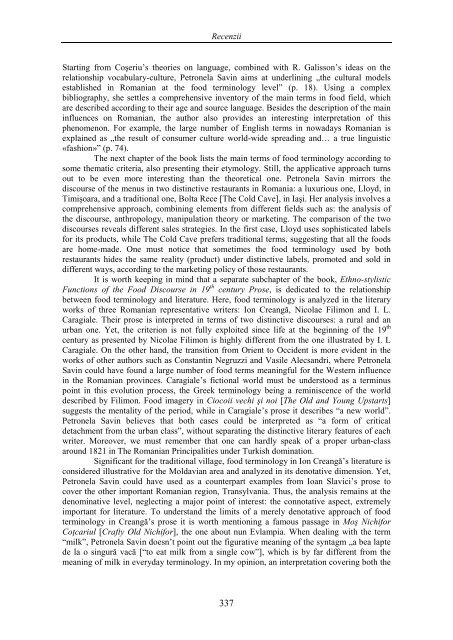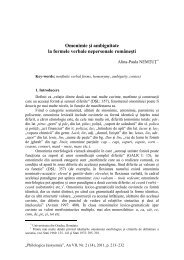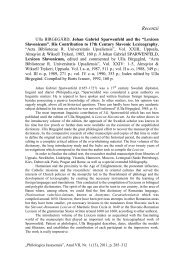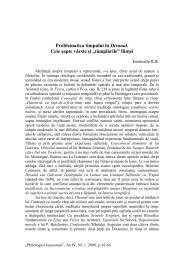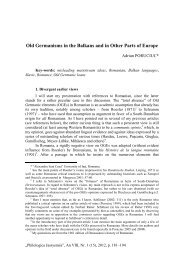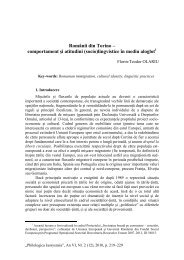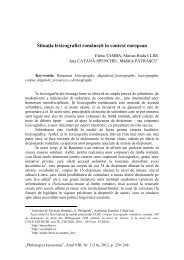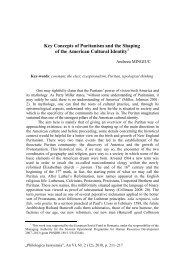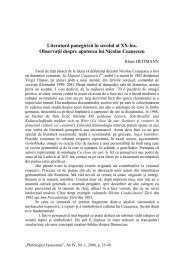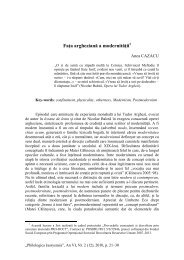Recenzii - Philologica Jassyensia
Recenzii - Philologica Jassyensia
Recenzii - Philologica Jassyensia
You also want an ePaper? Increase the reach of your titles
YUMPU automatically turns print PDFs into web optimized ePapers that Google loves.
<strong>Recenzii</strong><br />
Starting from Coşeriu’s theories on language, combined with R. Galisson’s ideas on the<br />
relationship vocabulary-culture, Petronela Savin aims at underlining „the cultural models<br />
established in Romanian at the food terminology level” (p. 18). Using a complex<br />
bibliography, she settles a comprehensive inventory of the main terms in food field, which<br />
are described according to their age and source language. Besides the description of the main<br />
influences on Romanian, the author also provides an interesting interpretation of this<br />
phenomenon. For example, the large number of English terms in nowadays Romanian is<br />
explained as „the result of consumer culture world-wide spreading and… a true linguistic<br />
«fashion»” (p. 74).<br />
The next chapter of the book lists the main terms of food terminology according to<br />
some thematic criteria, also presenting their etymology. Still, the applicative approach turns<br />
out to be even more interesting than the theoretical one. Petronela Savin mirrors the<br />
discourse of the menus in two distinctive restaurants in Romania: a luxurious one, Lloyd, in<br />
Timişoara, and a traditional one, Bolta Rece [The Cold Cave], in Iaşi. Her analysis involves a<br />
comprehensive approach, combining elements from different fields such as: the analysis of<br />
the discourse, anthropology, manipulation theory or marketing. The comparison of the two<br />
discourses reveals different sales strategies. In the first case, Lloyd uses sophisticated labels<br />
for its products, while The Cold Cave prefers traditional terms, suggesting that all the foods<br />
are home-made. One must notice that sometimes the food terminology used by both<br />
restaurants hides the same reality (product) under distinctive labels, promoted and sold in<br />
different ways, according to the marketing policy of those restaurants.<br />
It is worth keeping in mind that a separate subchapter of the book, Ethno-stylistic<br />
Functions of the Food Discourse in 19 th century Prose, is dedicated to the relationship<br />
between food terminology and literature. Here, food terminology is analyzed in the literary<br />
works of three Romanian representative writers: Ion Creangă, Nicolae Filimon and I. L.<br />
Caragiale. Their prose is interpreted in terms of two distinctive discourses: a rural and an<br />
urban one. Yet, the criterion is not fully exploited since life at the beginning of the 19 th<br />
century as presented by Nicolae Filimon is highly different from the one illustrated by I. L<br />
Caragiale. On the other hand, the transition from Orient to Occident is more evident in the<br />
works of other authors such as Constantin Negruzzi and Vasile Alecsandri, where Petronela<br />
Savin could have found a large number of food terms meaningful for the Western influence<br />
in the Romanian provinces. Caragiale’s fictional world must be understood as a terminus<br />
point in this evolution process, the Greek terminology being a reminiscence of the world<br />
described by Filimon. Food imagery in Ciocoii vechi şi noi [The Old and Young Upstarts]<br />
suggests the mentality of the period, while in Caragiale’s prose it describes “a new world”.<br />
Petronela Savin believes that both cases could be interpreted as “a form of critical<br />
detachment from the urban class”, without separating the distinctive literary features of each<br />
writer. Moreover, we must remember that one can hardly speak of a proper urban-class<br />
around 1821 in The Romanian Principalities under Turkish domination.<br />
Significant for the traditional village, food terminology in Ion Creangă’s literature is<br />
considered illustrative for the Moldavian area and analyzed in its denotative dimension. Yet,<br />
Petronela Savin could have used as a counterpart examples from Ioan Slavici’s prose to<br />
cover the other important Romanian region, Transylvania. Thus, the analysis remains at the<br />
denominative level, neglecting a major point of interest: the connotative aspect, extremely<br />
important for literature. To understand the limits of a merely denotative approach of food<br />
terminology in Creangă’s prose it is worth mentioning a famous passage in Moş Nichifor<br />
Coţcariul [Crafty Old Nichifor], the one about nun Evlampia. When dealing with the term<br />
“milk”, Petronela Savin doesn’t point out the figurative meaning of the syntagm „a bea lapte<br />
de la o singură vacă [“to eat milk from a single cow”], which is by far different from the<br />
meaning of milk in everyday terminology. In my opinion, an interpretation covering both the<br />
337


